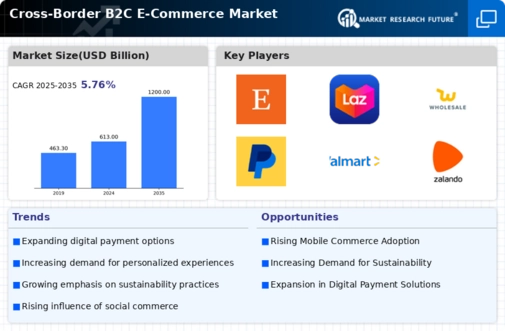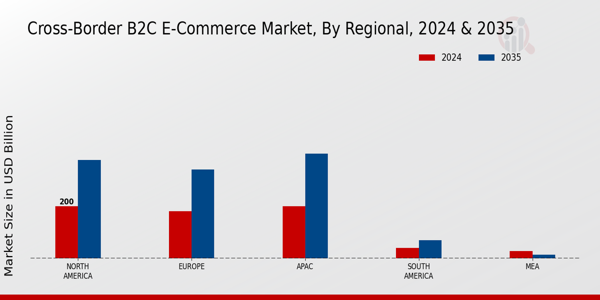-
EXECUTIVE SUMMARY
-
Market Overview
-
Key Findings
-
Market Segmentation
-
Competitive Landscape
-
Challenges and Opportunities
-
Future Outlook
-
MARKET INTRODUCTION
-
Definition
-
Scope of the study
- Research Objective
- Assumption
- Limitations
-
RESEARCH METHODOLOGY
-
Overview
-
Data Mining
-
Secondary Research
-
Primary Research
- Primary Interviews and Information Gathering Process
- Breakdown of Primary Respondents
-
Forecasting Model
-
Market Size Estimation
- Bottom-Up Approach
- Top-Down Approach
-
Data Triangulation
-
Validation
-
MARKET DYNAMICS
-
Overview
-
Drivers
-
Restraints
-
Opportunities
-
MARKET FACTOR ANALYSIS
-
Value chain Analysis
-
Porter's Five Forces Analysis
- Bargaining Power of Suppliers
- Bargaining Power of Buyers
- Threat of New Entrants
- Threat of Substitutes
- Intensity of Rivalry
-
COVID-19 Impact Analysis
- Market Impact Analysis
- Regional Impact
- Opportunity and Threat Analysis
-
CROSS-BORDER B2C E-COMMERCE MARKET, BY PRODUCT CATEGORY (USD BILLION)
-
Clothing
-
Electronics
-
Beauty and Personal Care
-
Home and Garden
-
Sports Equipment
-
CROSS-BORDER B2C E-COMMERCE MARKET, BY PAYMENT METHOD (USD BILLION)
-
Credit/Debit Cards
-
Digital Wallets
-
Bank Transfers
-
Cash on Delivery
-
Cryptocurrency
-
CROSS-BORDER B2C E-COMMERCE MARKET, BY CUSTOMER DEMOGRAPHICS (USD BILLION)
-
Millennials
-
Generation Z
-
Generation X
-
Baby Boomers
-
CROSS-BORDER B2C E-COMMERCE MARKET, BY SHIPPING METHOD (USD BILLION)
-
Standard Shipping
-
Express Shipping
-
Same-Day Delivery
-
Click and Collect
-
CROSS-BORDER B2C E-COMMERCE MARKET, BY REGIONAL (USD BILLION)
-
North America
- US
- Canada
-
Europe
- Germany
- UK
- France
- Russia
- Italy
- Spain
- Rest of Europe
-
APAC
- China
- India
- Japan
- South Korea
- Malaysia
- Thailand
- Indonesia
- Rest of APAC
-
South America
- Brazil
- Mexico
- Argentina
- Rest of South America
-
MEA
- GCC Countries
- South Africa
- Rest of MEA
-
COMPETITIVE LANDSCAPE
-
Overview
-
Competitive Analysis
-
Market share Analysis
-
Major Growth Strategy in the Cross-Border B2C E-Commerce Market
-
Competitive Benchmarking
-
Leading Players in Terms of Number of Developments in the Cross-Border B2C E-Commerce Market
-
Key developments and growth strategies
- New Product Launch/Service Deployment
- Merger & Acquisitions
- Joint Ventures
-
Major Players Financial Matrix
- Sales and Operating Income
- Major Players R&D Expenditure. 2023
-
COMPANY PROFILES
-
Amazon
- Financial Overview
- Products Offered
- Key Developments
- SWOT Analysis
- Key Strategies
-
Etsy
- Financial Overview
- Products Offered
- Key Developments
- SWOT Analysis
- Key Strategies
-
Lazada
- Financial Overview
- Products Offered
- Key Developments
- SWOT Analysis
- Key Strategies
-
JD.com
- Financial Overview
- Products Offered
- Key Developments
- SWOT Analysis
- Key Strategies
-
Wish Wholesale
- Financial Overview
- Products Offered
- Key Developments
- SWOT Analysis
- Key Strategies
-
PayPal
- Financial Overview
- Products Offered
- Key Developments
- SWOT Analysis
- Key Strategies
-
Wish
- Financial Overview
- Products Offered
- Key Developments
- SWOT Analysis
- Key Strategies
-
Walmart
- Financial Overview
- Products Offered
- Key Developments
- SWOT Analysis
- Key Strategies
-
Zalando
- Financial Overview
- Products Offered
- Key Developments
- SWOT Analysis
- Key Strategies
-
Target
- Financial Overview
- Products Offered
- Key Developments
- SWOT Analysis
- Key Strategies
-
Rakuten
- Financial Overview
- Products Offered
- Key Developments
- SWOT Analysis
- Key Strategies
-
Alibaba
- Financial Overview
- Products Offered
- Key Developments
- SWOT Analysis
- Key Strategies
-
Shopify
- Financial Overview
- Products Offered
- Key Developments
- SWOT Analysis
- Key Strategies
-
eBay
- Financial Overview
- Products Offered
- Key Developments
- SWOT Analysis
- Key Strategies
-
Flipkart
- Financial Overview
- Products Offered
- Key Developments
- SWOT Analysis
- Key Strategies
-
APPENDIX
-
References
-
Related Reports
-
LIST OF TABLES
-
LIST OF ASSUMPTIONS
-
NORTH AMERICA CROSS-BORDER B2C E-COMMERCE MARKET SIZE ESTIMATES & FORECAST, BY PRODUCT CATEGORY, 2019-2035 (USD BILLIONS)
-
NORTH AMERICA CROSS-BORDER B2C E-COMMERCE MARKET SIZE ESTIMATES & FORECAST, BY PAYMENT METHOD, 2019-2035 (USD BILLIONS)
-
NORTH AMERICA CROSS-BORDER B2C E-COMMERCE MARKET SIZE ESTIMATES & FORECAST, BY CUSTOMER DEMOGRAPHICS, 2019-2035 (USD BILLIONS)
-
NORTH AMERICA CROSS-BORDER B2C E-COMMERCE MARKET SIZE ESTIMATES & FORECAST, BY SHIPPING METHOD, 2019-2035 (USD BILLIONS)
-
NORTH AMERICA CROSS-BORDER B2C E-COMMERCE MARKET SIZE ESTIMATES & FORECAST, BY REGIONAL, 2019-2035 (USD BILLIONS)
-
US CROSS-BORDER B2C E-COMMERCE MARKET SIZE ESTIMATES & FORECAST, BY PRODUCT CATEGORY, 2019-2035 (USD BILLIONS)
-
US CROSS-BORDER B2C E-COMMERCE MARKET SIZE ESTIMATES & FORECAST, BY PAYMENT METHOD, 2019-2035 (USD BILLIONS)
-
US CROSS-BORDER B2C E-COMMERCE MARKET SIZE ESTIMATES & FORECAST, BY CUSTOMER DEMOGRAPHICS, 2019-2035 (USD BILLIONS)
-
US CROSS-BORDER B2C E-COMMERCE MARKET SIZE ESTIMATES & FORECAST, BY SHIPPING METHOD, 2019-2035 (USD BILLIONS)
-
US CROSS-BORDER B2C E-COMMERCE MARKET SIZE ESTIMATES & FORECAST, BY REGIONAL, 2019-2035 (USD BILLIONS)
-
CANADA CROSS-BORDER B2C E-COMMERCE MARKET SIZE ESTIMATES & FORECAST, BY PRODUCT CATEGORY, 2019-2035 (USD BILLIONS)
-
CANADA CROSS-BORDER B2C E-COMMERCE MARKET SIZE ESTIMATES & FORECAST, BY PAYMENT METHOD, 2019-2035 (USD BILLIONS)
-
CANADA CROSS-BORDER B2C E-COMMERCE MARKET SIZE ESTIMATES & FORECAST, BY CUSTOMER DEMOGRAPHICS, 2019-2035 (USD BILLIONS)
-
CANADA CROSS-BORDER B2C E-COMMERCE MARKET SIZE ESTIMATES & FORECAST, BY SHIPPING METHOD, 2019-2035 (USD BILLIONS)
-
CANADA CROSS-BORDER B2C E-COMMERCE MARKET SIZE ESTIMATES & FORECAST, BY REGIONAL, 2019-2035 (USD BILLIONS)
-
EUROPE CROSS-BORDER B2C E-COMMERCE MARKET SIZE ESTIMATES & FORECAST, BY PRODUCT CATEGORY, 2019-2035 (USD BILLIONS)
-
EUROPE CROSS-BORDER B2C E-COMMERCE MARKET SIZE ESTIMATES & FORECAST, BY PAYMENT METHOD, 2019-2035 (USD BILLIONS)
-
EUROPE CROSS-BORDER B2C E-COMMERCE MARKET SIZE ESTIMATES & FORECAST, BY CUSTOMER DEMOGRAPHICS, 2019-2035 (USD BILLIONS)
-
EUROPE CROSS-BORDER B2C E-COMMERCE MARKET SIZE ESTIMATES & FORECAST, BY SHIPPING METHOD, 2019-2035 (USD BILLIONS)
-
EUROPE CROSS-BORDER B2C E-COMMERCE MARKET SIZE ESTIMATES & FORECAST, BY REGIONAL, 2019-2035 (USD BILLIONS)
-
GERMANY CROSS-BORDER B2C E-COMMERCE MARKET SIZE ESTIMATES & FORECAST, BY PRODUCT CATEGORY, 2019-2035 (USD BILLIONS)
-
GERMANY CROSS-BORDER B2C E-COMMERCE MARKET SIZE ESTIMATES & FORECAST, BY PAYMENT METHOD, 2019-2035 (USD BILLIONS)
-
GERMANY CROSS-BORDER B2C E-COMMERCE MARKET SIZE ESTIMATES & FORECAST, BY CUSTOMER DEMOGRAPHICS, 2019-2035 (USD BILLIONS)
-
GERMANY CROSS-BORDER B2C E-COMMERCE MARKET SIZE ESTIMATES & FORECAST, BY SHIPPING METHOD, 2019-2035 (USD BILLIONS)
-
GERMANY CROSS-BORDER B2C E-COMMERCE MARKET SIZE ESTIMATES & FORECAST, BY REGIONAL, 2019-2035 (USD BILLIONS)
-
UK CROSS-BORDER B2C E-COMMERCE MARKET SIZE ESTIMATES & FORECAST, BY PRODUCT CATEGORY, 2019-2035 (USD BILLIONS)
-
UK CROSS-BORDER B2C E-COMMERCE MARKET SIZE ESTIMATES & FORECAST, BY PAYMENT METHOD, 2019-2035 (USD BILLIONS)
-
UK CROSS-BORDER B2C E-COMMERCE MARKET SIZE ESTIMATES & FORECAST, BY CUSTOMER DEMOGRAPHICS, 2019-2035 (USD BILLIONS)
-
UK CROSS-BORDER B2C E-COMMERCE MARKET SIZE ESTIMATES & FORECAST, BY SHIPPING METHOD, 2019-2035 (USD BILLIONS)
-
UK CROSS-BORDER B2C E-COMMERCE MARKET SIZE ESTIMATES & FORECAST, BY REGIONAL, 2019-2035 (USD BILLIONS)
-
FRANCE CROSS-BORDER B2C E-COMMERCE MARKET SIZE ESTIMATES & FORECAST, BY PRODUCT CATEGORY, 2019-2035 (USD BILLIONS)
-
FRANCE CROSS-BORDER B2C E-COMMERCE MARKET SIZE ESTIMATES & FORECAST, BY PAYMENT METHOD, 2019-2035 (USD BILLIONS)
-
FRANCE CROSS-BORDER B2C E-COMMERCE MARKET SIZE ESTIMATES & FORECAST, BY CUSTOMER DEMOGRAPHICS, 2019-2035 (USD BILLIONS)
-
FRANCE CROSS-BORDER B2C E-COMMERCE MARKET SIZE ESTIMATES & FORECAST, BY SHIPPING METHOD, 2019-2035 (USD BILLIONS)
-
FRANCE CROSS-BORDER B2C E-COMMERCE MARKET SIZE ESTIMATES & FORECAST, BY REGIONAL, 2019-2035 (USD BILLIONS)
-
RUSSIA CROSS-BORDER B2C E-COMMERCE MARKET SIZE ESTIMATES & FORECAST, BY PRODUCT CATEGORY, 2019-2035 (USD BILLIONS)
-
RUSSIA CROSS-BORDER B2C E-COMMERCE MARKET SIZE ESTIMATES & FORECAST, BY PAYMENT METHOD, 2019-2035 (USD BILLIONS)
-
RUSSIA CROSS-BORDER B2C E-COMMERCE MARKET SIZE ESTIMATES & FORECAST, BY CUSTOMER DEMOGRAPHICS, 2019-2035 (USD BILLIONS)
-
RUSSIA CROSS-BORDER B2C E-COMMERCE MARKET SIZE ESTIMATES & FORECAST, BY SHIPPING METHOD, 2019-2035 (USD BILLIONS)
-
RUSSIA CROSS-BORDER B2C E-COMMERCE MARKET SIZE ESTIMATES & FORECAST, BY REGIONAL, 2019-2035 (USD BILLIONS)
-
ITALY CROSS-BORDER B2C E-COMMERCE MARKET SIZE ESTIMATES & FORECAST, BY PRODUCT CATEGORY, 2019-2035 (USD BILLIONS)
-
ITALY CROSS-BORDER B2C E-COMMERCE MARKET SIZE ESTIMATES & FORECAST, BY PAYMENT METHOD, 2019-2035 (USD BILLIONS)
-
ITALY CROSS-BORDER B2C E-COMMERCE MARKET SIZE ESTIMATES & FORECAST, BY CUSTOMER DEMOGRAPHICS, 2019-2035 (USD BILLIONS)
-
ITALY CROSS-BORDER B2C E-COMMERCE MARKET SIZE ESTIMATES & FORECAST, BY SHIPPING METHOD, 2019-2035 (USD BILLIONS)
-
ITALY CROSS-BORDER B2C E-COMMERCE MARKET SIZE ESTIMATES & FORECAST, BY REGIONAL, 2019-2035 (USD BILLIONS)
-
SPAIN CROSS-BORDER B2C E-COMMERCE MARKET SIZE ESTIMATES & FORECAST, BY PRODUCT CATEGORY, 2019-2035 (USD BILLIONS)
-
SPAIN CROSS-BORDER B2C E-COMMERCE MARKET SIZE ESTIMATES & FORECAST, BY PAYMENT METHOD, 2019-2035 (USD BILLIONS)
-
SPAIN CROSS-BORDER B2C E-COMMERCE MARKET SIZE ESTIMATES & FORECAST, BY CUSTOMER DEMOGRAPHICS, 2019-2035 (USD BILLIONS)
-
SPAIN CROSS-BORDER B2C E-COMMERCE MARKET SIZE ESTIMATES & FORECAST, BY SHIPPING METHOD, 2019-2035 (USD BILLIONS)
-
SPAIN CROSS-BORDER B2C E-COMMERCE MARKET SIZE ESTIMATES & FORECAST, BY REGIONAL, 2019-2035 (USD BILLIONS)
-
REST OF EUROPE CROSS-BORDER B2C E-COMMERCE MARKET SIZE ESTIMATES & FORECAST, BY PRODUCT CATEGORY, 2019-2035 (USD BILLIONS)
-
REST OF EUROPE CROSS-BORDER B2C E-COMMERCE MARKET SIZE ESTIMATES & FORECAST, BY PAYMENT METHOD, 2019-2035 (USD BILLIONS)
-
REST OF EUROPE CROSS-BORDER B2C E-COMMERCE MARKET SIZE ESTIMATES & FORECAST, BY CUSTOMER DEMOGRAPHICS, 2019-2035 (USD BILLIONS)
-
REST OF EUROPE CROSS-BORDER B2C E-COMMERCE MARKET SIZE ESTIMATES & FORECAST, BY SHIPPING METHOD, 2019-2035 (USD BILLIONS)
-
REST OF EUROPE CROSS-BORDER B2C E-COMMERCE MARKET SIZE ESTIMATES & FORECAST, BY REGIONAL, 2019-2035 (USD BILLIONS)
-
APAC CROSS-BORDER B2C E-COMMERCE MARKET SIZE ESTIMATES & FORECAST, BY PRODUCT CATEGORY, 2019-2035 (USD BILLIONS)
-
APAC CROSS-BORDER B2C E-COMMERCE MARKET SIZE ESTIMATES & FORECAST, BY PAYMENT METHOD, 2019-2035 (USD BILLIONS)
-
APAC CROSS-BORDER B2C E-COMMERCE MARKET SIZE ESTIMATES & FORECAST, BY CUSTOMER DEMOGRAPHICS, 2019-2035 (USD BILLIONS)
-
APAC CROSS-BORDER B2C E-COMMERCE MARKET SIZE ESTIMATES & FORECAST, BY SHIPPING METHOD, 2019-2035 (USD BILLIONS)
-
APAC CROSS-BORDER B2C E-COMMERCE MARKET SIZE ESTIMATES & FORECAST, BY REGIONAL, 2019-2035 (USD BILLIONS)
-
CHINA CROSS-BORDER B2C E-COMMERCE MARKET SIZE ESTIMATES & FORECAST, BY PRODUCT CATEGORY, 2019-2035 (USD BILLIONS)
-
CHINA CROSS-BORDER B2C E-COMMERCE MARKET SIZE ESTIMATES & FORECAST, BY PAYMENT METHOD, 2019-2035 (USD BILLIONS)
-
CHINA CROSS-BORDER B2C E-COMMERCE MARKET SIZE ESTIMATES & FORECAST, BY CUSTOMER DEMOGRAPHICS, 2019-2035 (USD BILLIONS)
-
CHINA CROSS-BORDER B2C E-COMMERCE MARKET SIZE ESTIMATES & FORECAST, BY SHIPPING METHOD, 2019-2035 (USD BILLIONS)
-
CHINA CROSS-BORDER B2C E-COMMERCE MARKET SIZE ESTIMATES & FORECAST, BY REGIONAL, 2019-2035 (USD BILLIONS)
-
INDIA CROSS-BORDER B2C E-COMMERCE MARKET SIZE ESTIMATES & FORECAST, BY PRODUCT CATEGORY, 2019-2035 (USD BILLIONS)
-
INDIA CROSS-BORDER B2C E-COMMERCE MARKET SIZE ESTIMATES & FORECAST, BY PAYMENT METHOD, 2019-2035 (USD BILLIONS)
-
INDIA CROSS-BORDER B2C E-COMMERCE MARKET SIZE ESTIMATES & FORECAST, BY CUSTOMER DEMOGRAPHICS, 2019-2035 (USD BILLIONS)
-
INDIA CROSS-BORDER B2C E-COMMERCE MARKET SIZE ESTIMATES & FORECAST, BY SHIPPING METHOD, 2019-2035 (USD BILLIONS)
-
INDIA CROSS-BORDER B2C E-COMMERCE MARKET SIZE ESTIMATES & FORECAST, BY REGIONAL, 2019-2035 (USD BILLIONS)
-
JAPAN CROSS-BORDER B2C E-COMMERCE MARKET SIZE ESTIMATES & FORECAST, BY PRODUCT CATEGORY, 2019-2035 (USD BILLIONS)
-
JAPAN CROSS-BORDER B2C E-COMMERCE MARKET SIZE ESTIMATES & FORECAST, BY PAYMENT METHOD, 2019-2035 (USD BILLIONS)
-
JAPAN CROSS-BORDER B2C E-COMMERCE MARKET SIZE ESTIMATES & FORECAST, BY CUSTOMER DEMOGRAPHICS, 2019-2035 (USD BILLIONS)
-
JAPAN CROSS-BORDER B2C E-COMMERCE MARKET SIZE ESTIMATES & FORECAST, BY SHIPPING METHOD, 2019-2035 (USD BILLIONS)
-
JAPAN CROSS-BORDER B2C E-COMMERCE MARKET SIZE ESTIMATES & FORECAST, BY REGIONAL, 2019-2035 (USD BILLIONS)
-
SOUTH KOREA CROSS-BORDER B2C E-COMMERCE MARKET SIZE ESTIMATES & FORECAST, BY PRODUCT CATEGORY, 2019-2035 (USD BILLIONS)
-
SOUTH KOREA CROSS-BORDER B2C E-COMMERCE MARKET SIZE ESTIMATES & FORECAST, BY PAYMENT METHOD, 2019-2035 (USD BILLIONS)
-
SOUTH KOREA CROSS-BORDER B2C E-COMMERCE MARKET SIZE ESTIMATES & FORECAST, BY CUSTOMER DEMOGRAPHICS, 2019-2035 (USD BILLIONS)
-
SOUTH KOREA CROSS-BORDER B2C E-COMMERCE MARKET SIZE ESTIMATES & FORECAST, BY SHIPPING METHOD, 2019-2035 (USD BILLIONS)
-
SOUTH KOREA CROSS-BORDER B2C E-COMMERCE MARKET SIZE ESTIMATES & FORECAST, BY REGIONAL, 2019-2035 (USD BILLIONS)
-
MALAYSIA CROSS-BORDER B2C E-COMMERCE MARKET SIZE ESTIMATES & FORECAST, BY PRODUCT CATEGORY, 2019-2035 (USD BILLIONS)
-
MALAYSIA CROSS-BORDER B2C E-COMMERCE MARKET SIZE ESTIMATES & FORECAST, BY PAYMENT METHOD, 2019-2035 (USD BILLIONS)
-
MALAYSIA CROSS-BORDER B2C E-COMMERCE MARKET SIZE ESTIMATES & FORECAST, BY CUSTOMER DEMOGRAPHICS, 2019-2035 (USD BILLIONS)
-
MALAYSIA CROSS-BORDER B2C E-COMMERCE MARKET SIZE ESTIMATES & FORECAST, BY SHIPPING METHOD, 2019-2035 (USD BILLIONS)
-
MALAYSIA CROSS-BORDER B2C E-COMMERCE MARKET SIZE ESTIMATES & FORECAST, BY REGIONAL, 2019-2035 (USD BILLIONS)
-
THAILAND CROSS-BORDER B2C E-COMMERCE MARKET SIZE ESTIMATES & FORECAST, BY PRODUCT CATEGORY, 2019-2035 (USD BILLIONS)
-
THAILAND CROSS-BORDER B2C E-COMMERCE MARKET SIZE ESTIMATES & FORECAST, BY PAYMENT METHOD, 2019-2035 (USD BILLIONS)
-
THAILAND CROSS-BORDER B2C E-COMMERCE MARKET SIZE ESTIMATES & FORECAST, BY CUSTOMER DEMOGRAPHICS, 2019-2035 (USD BILLIONS)
-
THAILAND CROSS-BORDER B2C E-COMMERCE MARKET SIZE ESTIMATES & FORECAST, BY SHIPPING METHOD, 2019-2035 (USD BILLIONS)
-
THAILAND CROSS-BORDER B2C E-COMMERCE MARKET SIZE ESTIMATES & FORECAST, BY REGIONAL, 2019-2035 (USD BILLIONS)
-
INDONESIA CROSS-BORDER B2C E-COMMERCE MARKET SIZE ESTIMATES & FORECAST, BY PRODUCT CATEGORY, 2019-2035 (USD BILLIONS)
-
INDONESIA CROSS-BORDER B2C E-COMMERCE MARKET SIZE ESTIMATES & FORECAST, BY PAYMENT METHOD, 2019-2035 (USD BILLIONS)
-
INDONESIA CROSS-BORDER B2C E-COMMERCE MARKET SIZE ESTIMATES & FORECAST, BY CUSTOMER DEMOGRAPHICS, 2019-2035 (USD BILLIONS)
-
INDONESIA CROSS-BORDER B2C E-COMMERCE MARKET SIZE ESTIMATES & FORECAST, BY SHIPPING METHOD, 2019-2035 (USD BILLIONS)
-
INDONESIA CROSS-BORDER B2C E-COMMERCE MARKET SIZE ESTIMATES & FORECAST, BY REGIONAL, 2019-2035 (USD BILLIONS)
-
REST OF APAC CROSS-BORDER B2C E-COMMERCE MARKET SIZE ESTIMATES & FORECAST, BY PRODUCT CATEGORY, 2019-2035 (USD BILLIONS)
-
REST OF APAC CROSS-BORDER B2C E-COMMERCE MARKET SIZE ESTIMATES & FORECAST, BY PAYMENT METHOD, 2019-2035 (USD BILLIONS)
-
REST OF APAC CROSS-BORDER B2C E-COMMERCE MARKET SIZE ESTIMATES & FORECAST, BY CUSTOMER DEMOGRAPHICS, 2019-2035 (USD BILLIONS)
-
REST OF APAC CROSS-BORDER B2C E-COMMERCE MARKET SIZE ESTIMATES & FORECAST, BY SHIPPING METHOD, 2019-2035 (USD BILLIONS)
-
REST OF APAC CROSS-BORDER B2C E-COMMERCE MARKET SIZE ESTIMATES & FORECAST, BY REGIONAL, 2019-2035 (USD BILLIONS)
-
SOUTH AMERICA CROSS-BORDER B2C E-COMMERCE MARKET SIZE ESTIMATES & FORECAST, BY PRODUCT CATEGORY, 2019-2035 (USD BILLIONS)
-
SOUTH AMERICA CROSS-BORDER B2C E-COMMERCE MARKET SIZE ESTIMATES & FORECAST, BY PAYMENT METHOD, 2019-2035 (USD BILLIONS)
-
SOUTH AMERICA CROSS-BORDER B2C E-COMMERCE MARKET SIZE ESTIMATES & FORECAST, BY CUSTOMER DEMOGRAPHICS, 2019-2035 (USD BILLIONS)
-
SOUTH AMERICA CROSS-BORDER B2C E-COMMERCE MARKET SIZE ESTIMATES & FORECAST, BY SHIPPING METHOD, 2019-2035 (USD BILLIONS)
-
SOUTH AMERICA CROSS-BORDER B2C E-COMMERCE MARKET SIZE ESTIMATES & FORECAST, BY REGIONAL, 2019-2035 (USD BILLIONS)
-
BRAZIL CROSS-BORDER B2C E-COMMERCE MARKET SIZE ESTIMATES & FORECAST, BY PRODUCT CATEGORY, 2019-2035 (USD BILLIONS)
-
BRAZIL CROSS-BORDER B2C E-COMMERCE MARKET SIZE ESTIMATES & FORECAST, BY PAYMENT METHOD, 2019-2035 (USD BILLIONS)
-
BRAZIL CROSS-BORDER B2C E-COMMERCE MARKET SIZE ESTIMATES & FORECAST, BY CUSTOMER DEMOGRAPHICS, 2019-2035 (USD BILLIONS)
-
BRAZIL CROSS-BORDER B2C E-COMMERCE MARKET SIZE ESTIMATES & FORECAST, BY SHIPPING METHOD, 2019-2035 (USD BILLIONS)
-
BRAZIL CROSS-BORDER B2C E-COMMERCE MARKET SIZE ESTIMATES & FORECAST, BY REGIONAL, 2019-2035 (USD BILLIONS)
-
MEXICO CROSS-BORDER B2C E-COMMERCE MARKET SIZE ESTIMATES & FORECAST, BY PRODUCT CATEGORY, 2019-2035 (USD BILLIONS)
-
MEXICO CROSS-BORDER B2C E-COMMERCE MARKET SIZE ESTIMATES & FORECAST, BY PAYMENT METHOD, 2019-2035 (USD BILLIONS)
-
MEXICO CROSS-BORDER B2C E-COMMERCE MARKET SIZE ESTIMATES & FORECAST, BY CUSTOMER DEMOGRAPHICS, 2019-2035 (USD BILLIONS)
-
MEXICO CROSS-BORDER B2C E-COMMERCE MARKET SIZE ESTIMATES & FORECAST, BY SHIPPING METHOD, 2019-2035 (USD BILLIONS)
-
MEXICO CROSS-BORDER B2C E-COMMERCE MARKET SIZE ESTIMATES & FORECAST, BY REGIONAL, 2019-2035 (USD BILLIONS)
-
ARGENTINA CROSS-BORDER B2C E-COMMERCE MARKET SIZE ESTIMATES & FORECAST, BY PRODUCT CATEGORY, 2019-2035 (USD BILLIONS)
-
ARGENTINA CROSS-BORDER B2C E-COMMERCE MARKET SIZE ESTIMATES & FORECAST, BY PAYMENT METHOD, 2019-2035 (USD BILLIONS)
-
ARGENTINA CROSS-BORDER B2C E-COMMERCE MARKET SIZE ESTIMATES & FORECAST, BY CUSTOMER DEMOGRAPHICS, 2019-2035 (USD BILLIONS)
-
ARGENTINA CROSS-BORDER B2C E-COMMERCE MARKET SIZE ESTIMATES & FORECAST, BY SHIPPING METHOD, 2019-2035 (USD BILLIONS)
-
ARGENTINA CROSS-BORDER B2C E-COMMERCE MARKET SIZE ESTIMATES & FORECAST, BY REGIONAL, 2019-2035 (USD BILLIONS)
-
REST OF SOUTH AMERICA CROSS-BORDER B2C E-COMMERCE MARKET SIZE ESTIMATES & FORECAST, BY PRODUCT CATEGORY, 2019-2035 (USD BILLIONS)
-
REST OF SOUTH AMERICA CROSS-BORDER B2C E-COMMERCE MARKET SIZE ESTIMATES & FORECAST, BY PAYMENT METHOD, 2019-2035 (USD BILLIONS)
-
REST OF SOUTH AMERICA CROSS-BORDER B2C E-COMMERCE MARKET SIZE ESTIMATES & FORECAST, BY CUSTOMER DEMOGRAPHICS, 2019-2035 (USD BILLIONS)
-
REST OF SOUTH AMERICA CROSS-BORDER B2C E-COMMERCE MARKET SIZE ESTIMATES & FORECAST, BY SHIPPING METHOD, 2019-2035 (USD BILLIONS)
-
REST OF SOUTH AMERICA CROSS-BORDER B2C E-COMMERCE MARKET SIZE ESTIMATES & FORECAST, BY REGIONAL, 2019-2035 (USD BILLIONS)
-
MEA CROSS-BORDER B2C E-COMMERCE MARKET SIZE ESTIMATES & FORECAST, BY PRODUCT CATEGORY, 2019-2035 (USD BILLIONS)
-
MEA CROSS-BORDER B2C E-COMMERCE MARKET SIZE ESTIMATES & FORECAST, BY PAYMENT METHOD, 2019-2035 (USD BILLIONS)
-
MEA CROSS-BORDER B2C E-COMMERCE MARKET SIZE ESTIMATES & FORECAST, BY CUSTOMER DEMOGRAPHICS, 2019-2035 (USD BILLIONS)
-
MEA CROSS-BORDER B2C E-COMMERCE MARKET SIZE ESTIMATES & FORECAST, BY SHIPPING METHOD, 2019-2035 (USD BILLIONS)
-
MEA CROSS-BORDER B2C E-COMMERCE MARKET SIZE ESTIMATES & FORECAST, BY REGIONAL, 2019-2035 (USD BILLIONS)
-
GCC COUNTRIES CROSS-BORDER B2C E-COMMERCE MARKET SIZE ESTIMATES & FORECAST, BY PRODUCT CATEGORY, 2019-2035 (USD BILLIONS)
-
GCC COUNTRIES CROSS-BORDER B2C E-COMMERCE MARKET SIZE ESTIMATES & FORECAST, BY PAYMENT METHOD, 2019-2035 (USD BILLIONS)
-
GCC COUNTRIES CROSS-BORDER B2C E-COMMERCE MARKET SIZE ESTIMATES & FORECAST, BY CUSTOMER DEMOGRAPHICS, 2019-2035 (USD BILLIONS)
-
GCC COUNTRIES CROSS-BORDER B2C E-COMMERCE MARKET SIZE ESTIMATES & FORECAST, BY SHIPPING METHOD, 2019-2035 (USD BILLIONS)
-
GCC COUNTRIES CROSS-BORDER B2C E-COMMERCE MARKET SIZE ESTIMATES & FORECAST, BY REGIONAL, 2019-2035 (USD BILLIONS)
-
SOUTH AFRICA CROSS-BORDER B2C E-COMMERCE MARKET SIZE ESTIMATES & FORECAST, BY PRODUCT CATEGORY, 2019-2035 (USD BILLIONS)
-
SOUTH AFRICA CROSS-BORDER B2C E-COMMERCE MARKET SIZE ESTIMATES & FORECAST, BY PAYMENT METHOD, 2019-2035 (USD BILLIONS)
-
SOUTH AFRICA CROSS-BORDER B2C E-COMMERCE MARKET SIZE ESTIMATES & FORECAST, BY CUSTOMER DEMOGRAPHICS, 2019-2035 (USD BILLIONS)
-
SOUTH AFRICA CROSS-BORDER B2C E-COMMERCE MARKET SIZE ESTIMATES & FORECAST, BY SHIPPING METHOD, 2019-2035 (USD BILLIONS)
-
SOUTH AFRICA CROSS-BORDER B2C E-COMMERCE MARKET SIZE ESTIMATES & FORECAST, BY REGIONAL, 2019-2035 (USD BILLIONS)
-
REST OF MEA CROSS-BORDER B2C E-COMMERCE MARKET SIZE ESTIMATES & FORECAST, BY PRODUCT CATEGORY, 2019-2035 (USD BILLIONS)
-
REST OF MEA CROSS-BORDER B2C E-COMMERCE MARKET SIZE ESTIMATES & FORECAST, BY PAYMENT METHOD, 2019-2035 (USD BILLIONS)
-
REST OF MEA CROSS-BORDER B2C E-COMMERCE MARKET SIZE ESTIMATES & FORECAST, BY CUSTOMER DEMOGRAPHICS, 2019-2035 (USD BILLIONS)
-
REST OF MEA CROSS-BORDER B2C E-COMMERCE MARKET SIZE ESTIMATES & FORECAST, BY SHIPPING METHOD, 2019-2035 (USD BILLIONS)
-
REST OF MEA CROSS-BORDER B2C E-COMMERCE MARKET SIZE ESTIMATES & FORECAST, BY REGIONAL, 2019-2035 (USD BILLIONS)
-
PRODUCT LAUNCH/PRODUCT DEVELOPMENT/APPROVAL
-
ACQUISITION/PARTNERSHIP
-
LIST OF FIGURES
-
MARKET SYNOPSIS
-
NORTH AMERICA CROSS-BORDER B2C E-COMMERCE MARKET ANALYSIS
-
US CROSS-BORDER B2C E-COMMERCE MARKET ANALYSIS BY PRODUCT CATEGORY
-
US CROSS-BORDER B2C E-COMMERCE MARKET ANALYSIS BY PAYMENT METHOD
-
US CROSS-BORDER B2C E-COMMERCE MARKET ANALYSIS BY CUSTOMER DEMOGRAPHICS
-
US CROSS-BORDER B2C E-COMMERCE MARKET ANALYSIS BY SHIPPING METHOD
-
US CROSS-BORDER B2C E-COMMERCE MARKET ANALYSIS BY REGIONAL
-
CANADA CROSS-BORDER B2C E-COMMERCE MARKET ANALYSIS BY PRODUCT CATEGORY
-
CANADA CROSS-BORDER B2C E-COMMERCE MARKET ANALYSIS BY PAYMENT METHOD
-
CANADA CROSS-BORDER B2C E-COMMERCE MARKET ANALYSIS BY CUSTOMER DEMOGRAPHICS
-
CANADA CROSS-BORDER B2C E-COMMERCE MARKET ANALYSIS BY SHIPPING METHOD
-
CANADA CROSS-BORDER B2C E-COMMERCE MARKET ANALYSIS BY REGIONAL
-
EUROPE CROSS-BORDER B2C E-COMMERCE MARKET ANALYSIS
-
GERMANY CROSS-BORDER B2C E-COMMERCE MARKET ANALYSIS BY PRODUCT CATEGORY
-
GERMANY CROSS-BORDER B2C E-COMMERCE MARKET ANALYSIS BY PAYMENT METHOD
-
GERMANY CROSS-BORDER B2C E-COMMERCE MARKET ANALYSIS BY CUSTOMER DEMOGRAPHICS
-
GERMANY CROSS-BORDER B2C E-COMMERCE MARKET ANALYSIS BY SHIPPING METHOD
-
GERMANY CROSS-BORDER B2C E-COMMERCE MARKET ANALYSIS BY REGIONAL
-
UK CROSS-BORDER B2C E-COMMERCE MARKET ANALYSIS BY PRODUCT CATEGORY
-
UK CROSS-BORDER B2C E-COMMERCE MARKET ANALYSIS BY PAYMENT METHOD
-
UK CROSS-BORDER B2C E-COMMERCE MARKET ANALYSIS BY CUSTOMER DEMOGRAPHICS
-
UK CROSS-BORDER B2C E-COMMERCE MARKET ANALYSIS BY SHIPPING METHOD
-
UK CROSS-BORDER B2C E-COMMERCE MARKET ANALYSIS BY REGIONAL
-
FRANCE CROSS-BORDER B2C E-COMMERCE MARKET ANALYSIS BY PRODUCT CATEGORY
-
FRANCE CROSS-BORDER B2C E-COMMERCE MARKET ANALYSIS BY PAYMENT METHOD
-
FRANCE CROSS-BORDER B2C E-COMMERCE MARKET ANALYSIS BY CUSTOMER DEMOGRAPHICS
-
FRANCE CROSS-BORDER B2C E-COMMERCE MARKET ANALYSIS BY SHIPPING METHOD
-
FRANCE CROSS-BORDER B2C E-COMMERCE MARKET ANALYSIS BY REGIONAL
-
RUSSIA CROSS-BORDER B2C E-COMMERCE MARKET ANALYSIS BY PRODUCT CATEGORY
-
RUSSIA CROSS-BORDER B2C E-COMMERCE MARKET ANALYSIS BY PAYMENT METHOD
-
RUSSIA CROSS-BORDER B2C E-COMMERCE MARKET ANALYSIS BY CUSTOMER DEMOGRAPHICS
-
RUSSIA CROSS-BORDER B2C E-COMMERCE MARKET ANALYSIS BY SHIPPING METHOD
-
RUSSIA CROSS-BORDER B2C E-COMMERCE MARKET ANALYSIS BY REGIONAL
-
ITALY CROSS-BORDER B2C E-COMMERCE MARKET ANALYSIS BY PRODUCT CATEGORY
-
ITALY CROSS-BORDER B2C E-COMMERCE MARKET ANALYSIS BY PAYMENT METHOD
-
ITALY CROSS-BORDER B2C E-COMMERCE MARKET ANALYSIS BY CUSTOMER DEMOGRAPHICS
-
ITALY CROSS-BORDER B2C E-COMMERCE MARKET ANALYSIS BY SHIPPING METHOD
-
ITALY CROSS-BORDER B2C E-COMMERCE MARKET ANALYSIS BY REGIONAL
-
SPAIN CROSS-BORDER B2C E-COMMERCE MARKET ANALYSIS BY PRODUCT CATEGORY
-
SPAIN CROSS-BORDER B2C E-COMMERCE MARKET ANALYSIS BY PAYMENT METHOD
-
SPAIN CROSS-BORDER B2C E-COMMERCE MARKET ANALYSIS BY CUSTOMER DEMOGRAPHICS
-
SPAIN CROSS-BORDER B2C E-COMMERCE MARKET ANALYSIS BY SHIPPING METHOD
-
SPAIN CROSS-BORDER B2C E-COMMERCE MARKET ANALYSIS BY REGIONAL
-
REST OF EUROPE CROSS-BORDER B2C E-COMMERCE MARKET ANALYSIS BY PRODUCT CATEGORY
-
REST OF EUROPE CROSS-BORDER B2C E-COMMERCE MARKET ANALYSIS BY PAYMENT METHOD
-
REST OF EUROPE CROSS-BORDER B2C E-COMMERCE MARKET ANALYSIS BY CUSTOMER DEMOGRAPHICS
-
REST OF EUROPE CROSS-BORDER B2C E-COMMERCE MARKET ANALYSIS BY SHIPPING METHOD
-
REST OF EUROPE CROSS-BORDER B2C E-COMMERCE MARKET ANALYSIS BY REGIONAL
-
APAC CROSS-BORDER B2C E-COMMERCE MARKET ANALYSIS
-
CHINA CROSS-BORDER B2C E-COMMERCE MARKET ANALYSIS BY PRODUCT CATEGORY
-
CHINA CROSS-BORDER B2C E-COMMERCE MARKET ANALYSIS BY PAYMENT METHOD
-
CHINA CROSS-BORDER B2C E-COMMERCE MARKET ANALYSIS BY CUSTOMER DEMOGRAPHICS
-
CHINA CROSS-BORDER B2C E-COMMERCE MARKET ANALYSIS BY SHIPPING METHOD
-
CHINA CROSS-BORDER B2C E-COMMERCE MARKET ANALYSIS BY REGIONAL
-
INDIA CROSS-BORDER B2C E-COMMERCE MARKET ANALYSIS BY PRODUCT CATEGORY
-
INDIA CROSS-BORDER B2C E-COMMERCE MARKET ANALYSIS BY PAYMENT METHOD
-
INDIA CROSS-BORDER B2C E-COMMERCE MARKET ANALYSIS BY CUSTOMER DEMOGRAPHICS
-
INDIA CROSS-BORDER B2C E-COMMERCE MARKET ANALYSIS BY SHIPPING METHOD
-
INDIA CROSS-BORDER B2C E-COMMERCE MARKET ANALYSIS BY REGIONAL
-
JAPAN CROSS-BORDER B2C E-COMMERCE MARKET ANALYSIS BY PRODUCT CATEGORY
-
JAPAN CROSS-BORDER B2C E-COMMERCE MARKET ANALYSIS BY PAYMENT METHOD
-
JAPAN CROSS-BORDER B2C E-COMMERCE MARKET ANALYSIS BY CUSTOMER DEMOGRAPHICS
-
JAPAN CROSS-BORDER B2C E-COMMERCE MARKET ANALYSIS BY SHIPPING METHOD
-
JAPAN CROSS-BORDER B2C E-COMMERCE MARKET ANALYSIS BY REGIONAL
-
SOUTH KOREA CROSS-BORDER B2C E-COMMERCE MARKET ANALYSIS BY PRODUCT CATEGORY
-
SOUTH KOREA CROSS-BORDER B2C E-COMMERCE MARKET ANALYSIS BY PAYMENT METHOD
-
SOUTH KOREA CROSS-BORDER B2C E-COMMERCE MARKET ANALYSIS BY CUSTOMER DEMOGRAPHICS
-
SOUTH KOREA CROSS-BORDER B2C E-COMMERCE MARKET ANALYSIS BY SHIPPING METHOD
-
SOUTH KOREA CROSS-BORDER B2C E-COMMERCE MARKET ANALYSIS BY REGIONAL
-
MALAYSIA CROSS-BORDER B2C E-COMMERCE MARKET ANALYSIS BY PRODUCT CATEGORY
-
MALAYSIA CROSS-BORDER B2C E-COMMERCE MARKET ANALYSIS BY PAYMENT METHOD
-
MALAYSIA CROSS-BORDER B2C E-COMMERCE MARKET ANALYSIS BY CUSTOMER DEMOGRAPHICS
-
MALAYSIA CROSS-BORDER B2C E-COMMERCE MARKET ANALYSIS BY SHIPPING METHOD
-
MALAYSIA CROSS-BORDER B2C E-COMMERCE MARKET ANALYSIS BY REGIONAL
-
THAILAND CROSS-BORDER B2C E-COMMERCE MARKET ANALYSIS BY PRODUCT CATEGORY
-
THAILAND CROSS-BORDER B2C E-COMMERCE MARKET ANALYSIS BY PAYMENT METHOD
-
THAILAND CROSS-BORDER B2C E-COMMERCE MARKET ANALYSIS BY CUSTOMER DEMOGRAPHICS
-
THAILAND CROSS-BORDER B2C E-COMMERCE MARKET ANALYSIS BY SHIPPING METHOD
-
THAILAND CROSS-BORDER B2C E-COMMERCE MARKET ANALYSIS BY REGIONAL
-
INDONESIA CROSS-BORDER B2C E-COMMERCE MARKET ANALYSIS BY PRODUCT CATEGORY
-
INDONESIA CROSS-BORDER B2C E-COMMERCE MARKET ANALYSIS BY PAYMENT METHOD
-
INDONESIA CROSS-BORDER B2C E-COMMERCE MARKET ANALYSIS BY CUSTOMER DEMOGRAPHICS
-
INDONESIA CROSS-BORDER B2C E-COMMERCE MARKET ANALYSIS BY SHIPPING METHOD
-
INDONESIA CROSS-BORDER B2C E-COMMERCE MARKET ANALYSIS BY REGIONAL
-
REST OF APAC CROSS-BORDER B2C E-COMMERCE MARKET ANALYSIS BY PRODUCT CATEGORY
-
REST OF APAC CROSS-BORDER B2C E-COMMERCE MARKET ANALYSIS BY PAYMENT METHOD
-
REST OF APAC CROSS-BORDER B2C E-COMMERCE MARKET ANALYSIS BY CUSTOMER DEMOGRAPHICS
-
REST OF APAC CROSS-BORDER B2C E-COMMERCE MARKET ANALYSIS BY SHIPPING METHOD
-
REST OF APAC CROSS-BORDER B2C E-COMMERCE MARKET ANALYSIS BY REGIONAL
-
SOUTH AMERICA CROSS-BORDER B2C E-COMMERCE MARKET ANALYSIS
-
BRAZIL CROSS-BORDER B2C E-COMMERCE MARKET ANALYSIS BY PRODUCT CATEGORY
-
BRAZIL CROSS-BORDER B2C E-COMMERCE MARKET ANALYSIS BY PAYMENT METHOD
-
BRAZIL CROSS-BORDER B2C E-COMMERCE MARKET ANALYSIS BY CUSTOMER DEMOGRAPHICS
-
BRAZIL CROSS-BORDER B2C E-COMMERCE MARKET ANALYSIS BY SHIPPING METHOD
-
BRAZIL CROSS-BORDER B2C E-COMMERCE MARKET ANALYSIS BY REGIONAL
-
MEXICO CROSS-BORDER B2C E-COMMERCE MARKET ANALYSIS BY PRODUCT CATEGORY
-
MEXICO CROSS-BORDER B2C E-COMMERCE MARKET ANALYSIS BY PAYMENT METHOD
-
MEXICO CROSS-BORDER B2C E-COMMERCE MARKET ANALYSIS BY CUSTOMER DEMOGRAPHICS
-
MEXICO CROSS-BORDER B2C E-COMMERCE MARKET ANALYSIS BY SHIPPING METHOD
-
MEXICO CROSS-BORDER B2C E-COMMERCE MARKET ANALYSIS BY REGIONAL
-
ARGENTINA CROSS-BORDER B2C E-COMMERCE MARKET ANALYSIS BY PRODUCT CATEGORY
-
ARGENTINA CROSS-BORDER B2C E-COMMERCE MARKET ANALYSIS BY PAYMENT METHOD
-
ARGENTINA CROSS-BORDER B2C E-COMMERCE MARKET ANALYSIS BY CUSTOMER DEMOGRAPHICS
-
ARGENTINA CROSS-BORDER B2C E-COMMERCE MARKET ANALYSIS BY SHIPPING METHOD
-
ARGENTINA CROSS-BORDER B2C E-COMMERCE MARKET ANALYSIS BY REGIONAL
-
REST OF SOUTH AMERICA CROSS-BORDER B2C E-COMMERCE MARKET ANALYSIS BY PRODUCT CATEGORY
-
REST OF SOUTH AMERICA CROSS-BORDER B2C E-COMMERCE MARKET ANALYSIS BY PAYMENT METHOD
-
REST OF SOUTH AMERICA CROSS-BORDER B2C E-COMMERCE MARKET ANALYSIS BY CUSTOMER DEMOGRAPHICS
-
REST OF SOUTH AMERICA CROSS-BORDER B2C E-COMMERCE MARKET ANALYSIS BY SHIPPING METHOD
-
REST OF SOUTH AMERICA CROSS-BORDER B2C E-COMMERCE MARKET ANALYSIS BY REGIONAL
-
MEA CROSS-BORDER B2C E-COMMERCE MARKET ANALYSIS
-
GCC COUNTRIES CROSS-BORDER B2C E-COMMERCE MARKET ANALYSIS BY PRODUCT CATEGORY
-
GCC COUNTRIES CROSS-BORDER B2C E-COMMERCE MARKET ANALYSIS BY PAYMENT METHOD
-
GCC COUNTRIES CROSS-BORDER B2C E-COMMERCE MARKET ANALYSIS BY CUSTOMER DEMOGRAPHICS
-
GCC COUNTRIES CROSS-BORDER B2C E-COMMERCE MARKET ANALYSIS BY SHIPPING METHOD
-
GCC COUNTRIES CROSS-BORDER B2C E-COMMERCE MARKET ANALYSIS BY REGIONAL
-
SOUTH AFRICA CROSS-BORDER B2C E-COMMERCE MARKET ANALYSIS BY PRODUCT CATEGORY
-
SOUTH AFRICA CROSS-BORDER B2C E-COMMERCE MARKET ANALYSIS BY PAYMENT METHOD
-
SOUTH AFRICA CROSS-BORDER B2C E-COMMERCE MARKET ANALYSIS BY CUSTOMER DEMOGRAPHICS
-
SOUTH AFRICA CROSS-BORDER B2C E-COMMERCE MARKET ANALYSIS BY SHIPPING METHOD
-
SOUTH AFRICA CROSS-BORDER B2C E-COMMERCE MARKET ANALYSIS BY REGIONAL
-
REST OF MEA CROSS-BORDER B2C E-COMMERCE MARKET ANALYSIS BY PRODUCT CATEGORY
-
REST OF MEA CROSS-BORDER B2C E-COMMERCE MARKET ANALYSIS BY PAYMENT METHOD
-
REST OF MEA CROSS-BORDER B2C E-COMMERCE MARKET ANALYSIS BY CUSTOMER DEMOGRAPHICS
-
REST OF MEA CROSS-BORDER B2C E-COMMERCE MARKET ANALYSIS BY SHIPPING METHOD
-
REST OF MEA CROSS-BORDER B2C E-COMMERCE MARKET ANALYSIS BY REGIONAL
-
KEY BUYING CRITERIA OF CROSS-BORDER B2C E-COMMERCE MARKET
-
RESEARCH PROCESS OF MRFR
-
DRO ANALYSIS OF CROSS-BORDER B2C E-COMMERCE MARKET
-
DRIVERS IMPACT ANALYSIS: CROSS-BORDER B2C E-COMMERCE MARKET
-
RESTRAINTS IMPACT ANALYSIS: CROSS-BORDER B2C E-COMMERCE MARKET
-
SUPPLY / VALUE CHAIN: CROSS-BORDER B2C E-COMMERCE MARKET
-
CROSS-BORDER B2C E-COMMERCE MARKET, BY PRODUCT CATEGORY, 2025 (% SHARE)
-
CROSS-BORDER B2C E-COMMERCE MARKET, BY PRODUCT CATEGORY, 2019 TO 2035 (USD Billions)
-
CROSS-BORDER B2C E-COMMERCE MARKET, BY PAYMENT METHOD, 2025 (% SHARE)
-
CROSS-BORDER B2C E-COMMERCE MARKET, BY PAYMENT METHOD, 2019 TO 2035 (USD Billions)
-
CROSS-BORDER B2C E-COMMERCE MARKET, BY CUSTOMER DEMOGRAPHICS, 2025 (% SHARE)
-
CROSS-BORDER B2C E-COMMERCE MARKET, BY CUSTOMER DEMOGRAPHICS, 2019 TO 2035 (USD Billions)
-
CROSS-BORDER B2C E-COMMERCE MARKET, BY SHIPPING METHOD, 2025 (% SHARE)
-
CROSS-BORDER B2C E-COMMERCE MARKET, BY SHIPPING METHOD, 2019 TO 2035 (USD Billions)
-
CROSS-BORDER B2C E-COMMERCE MARKET, BY REGIONAL, 2025 (% SHARE)
-
CROSS-BORDER B2C E-COMMERCE MARKET, BY REGIONAL, 2019 TO 2035 (USD Billions)
-
BENCHMARKING OF MAJOR COMPETITORS










Leave a Comment